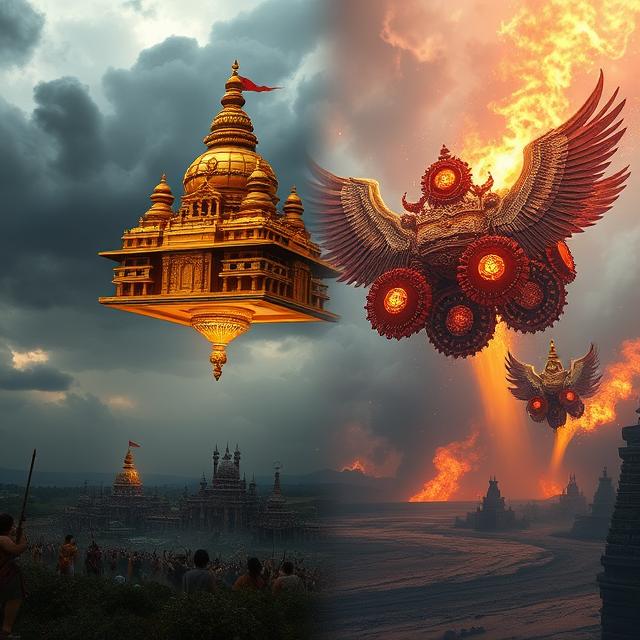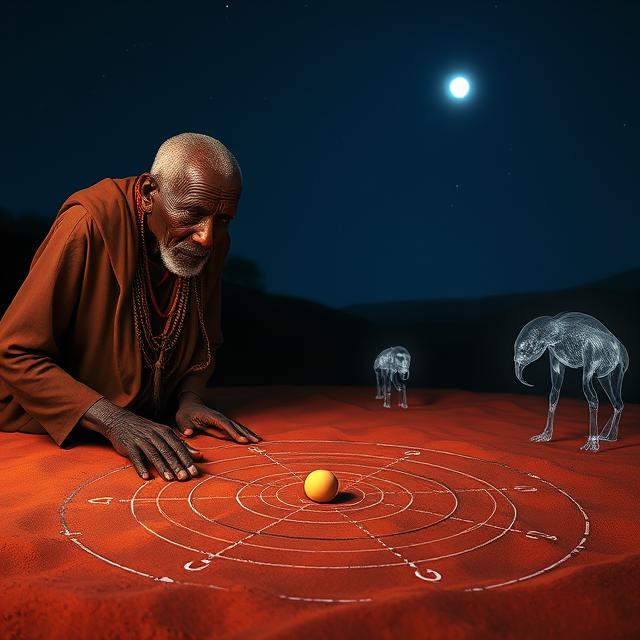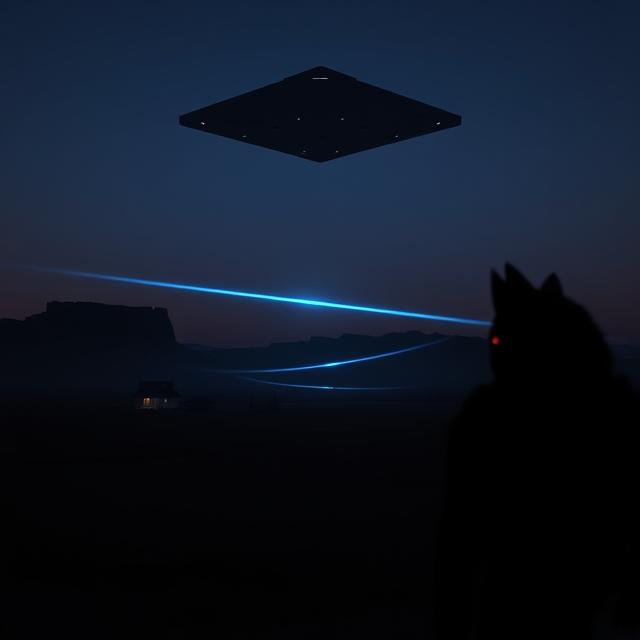Across cultures and millennia, ancient texts have spoken of gods and heavenly beings traversing the skies in magnificent, fiery chariots. From the epic poems of India to the prophetic visions of the Hebrew Bible, these accounts describe conveyances of awesome power and otherworldly design. To the modern mind, these descriptions can sound eerily like accounts of advanced technology. This has given rise to one of the most provocative and enduring questions in the study of antiquity: are these just poetic metaphors for divine power, or could they be “eyewitness” accounts of sophisticated flying machines, a forgotten chapter of technological history or even evidence of extraterrestrial contact?
Two of the most compelling examples of these phenomena are the Vimanas of Hindu scripture and the fiery Merkabah chariot seen by the prophet Ezekiel. For ancient astronaut theorists, these are smoking guns—clear descriptions of nuts-and-bolts spacecraft interpreted through a pre-industrial lens. For historians, theologians, and literary scholars, they are powerful symbols, rich with cultural and spiritual meaning, that speak to humanity’s relationship with the divine. This exploration will delve into the texts themselves, examining the claims of ancient technology against the backdrop of mythology and faith.
The Vimanas: Flying Palaces of the Vedic Gods
The ancient Sanskrit epics of India, particularly the Mahabharata and the Ramayana, are filled with vivid descriptions of flying chariots or palaces known as Vimanas. These are not simple horse-drawn carts; they are described as self-propelled aerial vehicles that could travel vast distances, move at incredible speeds, and sometimes even journey between worlds.
One of the most famous examples is the Pushpaka Vimana. Originally built by the divine craftsman Vishwakarma for Brahma, the creator god, it was a colossal flying palace that could accommodate any number of people, magically expanding its capacity as needed. The Ramayana describes how it was stolen by the demon king Ravana and later used by the hero Rama to return to his kingdom after a great war. The text states it moved at the pilot’s will and resembled “a bright cloud in the sky.”
Other texts, like the Mahabharata, describe Vimanas used in warfare, capable of unleashing powerful, destructive weapons. Descriptions of a weapon called the “Brahmastra” evoke comparisons to modern nuclear devastation, speaking of a “blazing shaft possessed of the effulgence of a smokeless fire” that could make the bodies of the dead unidentifiable and poison the land for years. These dramatic accounts have led many to speculate that these epics are not myths, but rather distorted histories of a technologically advanced civilization, one that possessed the power of flight and weapons of mass destruction.
The Vimanika Shastra: A Blueprint for Ancient Aircraft?
The debate over Vimanas as physical craft was significantly fueled in the 20th century by the emergence of a text called the Vimanika Shastra (Science of Aeronautics). This Sanskrit text, supposedly written by the ancient sage Bharadwaja and rediscovered in the early 1900s, purports to be a detailed manual on the construction and operation of Vimanas. It describes different types of flying machines, such as the Shakuna Vimana (resembling a bird) and the Tripura Vimana (a larger, three-tiered craft).
The text goes into seemingly technical detail about the metals required (alloys of lead, copper, and zinc), the power sources (including mercury vortex engines), and the various functions of the craft, from flight to invisibility. For proponents of the ancient astronaut theory, the Vimanika Shastra is definitive proof—an ancient technical manual that predates the Wright brothers by millennia.
The Scholarly Rebuttal: Mythology and Modern Misinterpretation
However, mainstream academia and science have overwhelmingly rejected the idea of Vimanas as physical hardware. When scholars and engineers examined the Vimanika Shastra, they found it to be anything but an ancient technical document. A landmark 1974 study by researchers at the prestigious Indian Institute of Science in Bangalore concluded that the text was a 20th-century fabrication, likely written between 1900 and 1922.
The study found numerous fatal flaws. The designs described in the text were deemed “un-aerodynamic” and “a decided impossibility” from an engineering standpoint. The principles of propulsion, far from being advanced, were often nonsensical and would resist flight rather than enable it. Furthermore, the language used in the text was modern Sanskrit, not the ancient Vedic form one would expect from a genuine ancient text. The conclusion was clear: the Vimanika Shastra was not a lost scientific manual but a modern work of fiction created in an era fascinated with the dawn of aviation, masquerading as ancient wisdom.
From a mythological perspective, scholars argue that interpreting Vimanas as literal machines is to miss their true purpose. In Hindu cosmology, these flying chariots are powerful symbols of sovereignty and divinity. They are not technology accessible to mortals but are the exclusive vehicles of gods, kings, and demons, representing their power to transcend the earthly realm. The chariot is a common Indo-European symbol of status and power, and the Vimana is the ultimate expression of that—a celestial throne. To read it as a blueprint for a helicopter is to strip it of its profound cultural and religious meaning, reducing a rich metaphor to a simplistic, anachronistic claim.
Ezekiel’s Chariot: A Vision of God or a Visiting Spacecraft?
Halfway across the world, another ancient text presents a similarly baffling and awe-inspiring image of a flying object. The Book of Ezekiel, written in the 6th century BCE while the Israelites were in exile in Babylon, opens with one of the most dramatic and enigmatic visions in the Bible.
The prophet Ezekiel describes a “great cloud with raging fire,” and from within it, the likeness of four “living creatures.” Each creature has four faces (that of a human, a lion, an ox, and an eagle), four wings, and legs like burnished bronze. Beside each of these creatures is a terrifying wheel, described as a “wheel within a wheel,” that could move in any of the four cardinal directions without turning. The rims of these wheels were “high and awesome” and were “full of eyes all around.” Above the creatures was a “vault, sparkling like crystal,” and upon this vault was a throne of sapphire, upon which sat a figure with the “likeness of a human being,” glowing like fire and radiating a brilliant light like a rainbow.
The Technological Interpretation: A NASA Engineer’s Analysis
For centuries, this vision was understood as a profound, albeit complex, piece of religious symbolism. But in 1974, the same year the Vimanika Shastra was debunked, a new interpretation was offered from an unlikely source. Josef F. Blumrich, a former NASA engineer who had worked on the Saturn V rocket program, published a book titled The Spaceships of Ezekiel.
Blumrich, initially setting out to disprove the ancient astronaut theories of authors like Erich von Däniken, became convinced that Ezekiel’s description was not a mystical vision but an accurate technical account of a spacecraft. Applying his engineering expertise, Blumrich claimed to have “reverse-engineered” the craft. He argued that the four living creatures were the four legs of a landing module, each with helicopter-like rotors (the wings) and landing pads (the calf’s feet). The “wheel within a wheel” was his inspiration for a patented omnidirectional wheel, capable of moving in any direction. The glowing figure on the throne was the commander of the craft, seen through the cockpit. Blumrich produced detailed technical drawings, arguing that Ezekiel’s vision was a credible description of a single-stage-to-orbit shuttlecraft.
The Theological Rebuttal: The Glory of the Lord on the Move
As with Vimanas, the overwhelming consensus among biblical scholars and theologians is that Blumrich’s literal interpretation misses the entire point of the vision. The Book of Ezekiel was written to a people in crisis. The Israelites had been conquered, their king exiled, and their sacred Temple in Jerusalem—the place they believed God dwelled on Earth—was soon to be destroyed. Their faith was shaken, and they felt abandoned by God.
Ezekiel’s vision is a powerful theological response to this crisis. It is not a spaceship; it is a “throne-chariot,” the Merkabah, which represents the mobile, transcendent glory of God. The message is clear: God is not confined to the Temple in Jerusalem. His power is not limited by geography. He is a universal King whose throne can move anywhere. He is with his people, even in the heart of their exile in pagan Babylon.
The bizarre imagery is deeply symbolic within the context of ancient Near Eastern iconography. The four faces of the living creatures—human, lion, ox, and eagle—represent the pinnacle of different aspects of creation (intelligence, wildness, domesticity, and the sky), all serving God. The “eyes” on the wheels do not represent literal portholes but symbolize God’s omniscience—His ability to see and know everything. The wheels that can move in any direction without turning represent His omnipresence—His ability to be and act anywhere, instantly. The entire vision is a breathtaking artistic and theological masterpiece designed to convey the awesome, untamable, and all-powerful nature of God to a people who felt hopeless and abandoned.
Conclusion: Symbolism vs. Nuts and Bolts
The desire to see advanced technology in ancient texts is understandable. It speaks to a yearning to believe that our ancestors were more advanced than we imagine, and it offers a sensational explanation for mysteries that seem to defy conventional historical understanding. The descriptions of Vimanas and Ezekiel’s Chariot are undeniably vivid and strange, and their superficial resemblance to modern aircraft is intriguing.
However, the evidence for a literal, technological interpretation is exceedingly thin. In the case of the Vimanika Shastra, it rests on a proven modern forgery. In the case of Ezekiel’s Chariot, it requires ignoring the profound historical, cultural, and theological context in which the vision was received.
Ultimately, the power of these ancient texts lies not in their potential as hidden technical manuals, but in their original purpose. They are soaring works of religious imagination, using the most powerful imagery available to them—fiery chariots, flying palaces, and heavenly thrones—to articulate humanity’s deepest questions about power, divinity, and our place in the cosmos. They are not blueprints for flying machines, but blueprints for understanding the divine.
Want to explore the shadows even deeper? For more chilling cases like this, visit SinisterArchive.com, where the legends are real.




